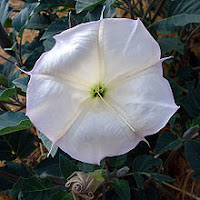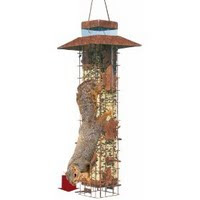
Mars and I have had a chipmunk-in-residence at this house for as long back as we can remember – sometimes two – but 95% of the time just one. We don’t see him (or her) everyday, or even every week – especially during the colder weather when he apparently goes into a light dormant state, awakening periodically to nibble on the food he has stashed with him for the seasonal sleep-in.
Usually, when we do spy him, he is darting into our garage through the slight gap between the overhead door bottom and the driveway. His second-most popular spot is hanging around the side door of said garage, which we can look upon from our south-facing kitchen window. And when the weather warms up he can also be spotted scurrying into one of our drainpipes when we surprise him doing whatever it is that chipmunks do around downspouts.
Oddly, the least common place to see the chipmunk is in the vicinity of our bird feeders. Maybe the squirrels scare him away – although we have never seen any such confrontation. Perhaps he is there more than we realize but his brown camouflage pelt blends in too well with the coffee-colored pine bark mulch that covers the surrounding ground. Or it could be that he dines during the evening hours when the buffet lines are pretty much empty, and Mars and I just aren’t watching.
On those rare occasions when we do see him at the eateries he has always been scrambling about on the ground beneath them, flipping through the debris that has been scattered by the less-than-neat eating birds and squirrels that actually take their food directly from the opening in the plastic feeding tubes. But never, not ever, have we seen the light and dark striped ground squirrel consuming food anywhere other than – the ground.
And then the other day I was on the second floor when Mars called up to me, “Quick. Look out the front bedroom window. The 'chipster' is on one of the feeders.”
By the time that I got to the viewing area, he was leaving. But I did see enough to figure out what was going on.
Ironically the diner he was vacating was the only one we have that has ever proven to be effectively squirrel-proof.
It’s a homemade job, designed by the owner-operator of a “Wild Bird’s Unlimited” emporium in the town just across the Connecticut River from our home base. I went looking for something from which the squirrels could not eat. He showed me several, most in the same price range as our house when we bought it 35 years ago. Sensing my lack of enthusiasm for investing our retirement savings into such a device, he offered that I could construct my very own impenetrable food fortress by placing a relatively inexpensive plastic cylindrical “Droll Yankee” feeder inside a slightly larger metal cage of the same shape (sold separately) with openings large enough for basically every bird that I want to attract, but way too small for squirrels.
Obviously the apertures were not too little for chipmunks.
A couple of days later we saw him again inside the same encaged eatery. He was affixed squirrel-like to the plastic cylinder, upside down, wolfing down the black oily sunflower seeds. I was on my way out, but I waited as long as I could to study his eating habits. They were pretty much as described in the preceding. I opened the family room door and he scampered rapidly out through the nearest available opening in the cage, up the lattice, up the suspending chain, and onto the flowering crab tree from which most of our cafes dangle. Then I lost sight of him.
That evening, when I was refilling the feeders, I noticed that the cage-enclosed one was abnormally low – down by more than enough sunflower kernels to fatten up an overindulging chipmunk to several times the size of the opening through which it gained access. And yet he was not imprisoned within. I hadn’t noticed any significant avian traffic at the “Droll Yankee” during the day, so I suspect that the little brown ground squirrel was responsible for most of the shortage. Probably, like during the cold months, he took it back to his secret lair to snack on later. But what if someday he decides not to do “take out”, and instead settles himself in one the perches and just spends the day chowing down in situ.
This is something that I choose not to think about. The design of my homemade squirrel-proof/chipmunk-friendly feeder does not include an escape hatch for the suddenly obese. Once again, as he usually is, “the chipster” is on his own.




